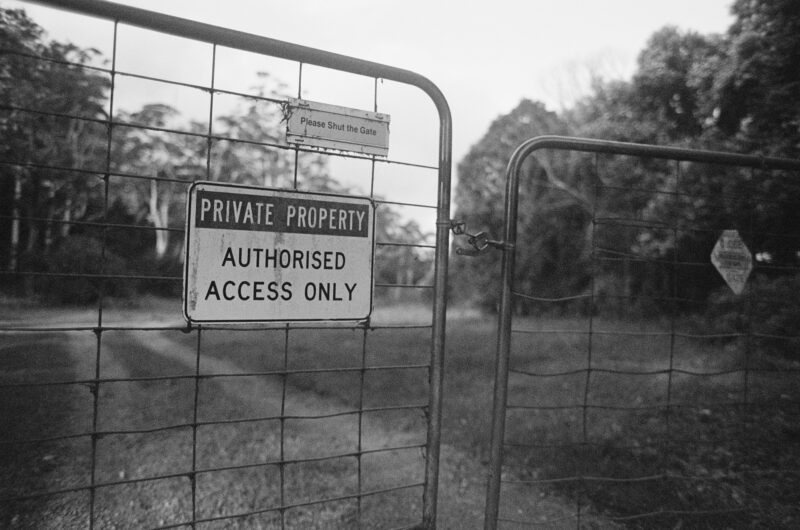Many organizations have IP notices and many are wrong. In some cases having the wrong patent notice creates a liability for you. Since these warnings are easy to write and place, most organizations should use them. In 2022 we blogged about on this topic. However, the law has changed.
Overview
You, as an owner of intellectual property (IP), have certain rights you can enforce if IP is infringed on by others. You can sent direct notice in a letter to an infringer but takes much effort. A general marking or notice is another way to communicate ownership and potential for action.

Notice versus marking
Both words are used and often one defines the other. For example, “A marking is a visual notice …” Some people call these disclaimers but that isn’t a good description since, if anything, they are making a claim.
Good notice practices
We see these notices everywhere. Often IP notices have errors in them so don’t copy them.
The process is simple. Consider what rights you want to give notice for. Consider where you will be placing the notice. Then make simple statements that identify the rights and the owner.
Copyright
In your copyright notice, all you need to do is:
- declare the work is copyrighted,
- state the year, and
- state the owner.
Both copyright symbol © or the word copyright are acceptable ways to declare copyright. The year is a bit tricky. It can be the first year of existence or publication. But if you update the work (e.g., website, code) you likely will want to list a range of dates corresponding to the year of the first version and the year of the last edit. The owner’s name can be your trade name, familiar name, or legal name.
Here are two examples:
- © 2024, Perpetual Patents
- Copyright 2018 – 2024, Perpetual Motion Patents Ltd.
Common mistakes
There are a few common mistakes.
- You don’t have to list your legal name. Think of authors that use a pen name. So, consider if you need to list the legal name right down to the Inc. or Ltd. (Warning you do need to list the owner of a trademark.)
- It is very common to see “All rights reserved.” This phrase has carried no legal weight since 2000. It was commercially irrelevant since the 80s. But sometimes people want to be emphatic so “All rights reserved” is better than “we mean it”.
- Sometimes people include both © and Copyright but we would never say copyright copyright. So why write it twice?
Here are a few bad examples that mostly get the job done:
- Copyright © 2024 Slaw. All Rights Reserved.
- Royal Bank of Canada Website, © 1995-2024
- © LegalZoom.com, Inc. All rights reserved.
- Copyright © 2024, Province of British Columbia. All rights reserved.
Copyright marking isn’t required under Canadian and British law but is in the United States and other countries. For more information on IP notices, see:
- CIPO, 2024 “Copyright information—Beyond the basics” URL
- UKIPO, 2024 “Copyright” United Kingdom Intellectual Property Office, URL
- United States, 2021 “Circular 3, Copyright Notice” United States Copyright Office, URL
Patent markings
Patent notices are more complicated. The advice varies by country, the nature of the product, and whether the patent has been granted.
The basic reason for marking is the patentee or licensee cannot recover damages from an infringer unless they have given notice of their rights either to the whole public by marking the article as “Patented”, or by informing the alleged infringer of the patent. Generally, it is easier and more advantageous to inform the public. In U.S. law this is called “constructive notice”.
Patent pending
For applications, you can use the phrase “Patent Pending” but only after you have filed a patent application. This includes a U.S. provisional patent application.
For patents, you need to associate products with a patent specified by number. For example, “U.S. Pat. No. XX,XXX,XXX”. You don’t need to name the patent owner.
Notice requirements on methods differ by country. For example, in the U.S. methods don’t need to be marked.
In the U.S. you can forgo placing the notice on the article or its packaging and use virtual markings. For more information patent markings see:
- Michelle K. Lee, 2014 “Report on virtual marking” USPTO
- 35 U.S.C. §287(a)
- CIPO, 2020 “Doing business abroad: Protecting your IP in the United States” CIPO
Warning
Before 2013, third parties file a claim for false patent marking. Indeed, patent lawyers would go to stores to find products which were not patented or where the patents had expired. This largely ended with the America Invents Act, but late in 2024 this practice may be back.
See Crocs, Inc. v. Effervescent, Inc. (Case: 22-2160 , reasons of 2024 Oct 3) where the Federal Circuit held that falsely advertising a product as “patented” can give rise to liability under the Lanham Act‘s prohibition on false advertising. This ruling means you could be sued for falsely claiming patent protection if you are using it to imply the quality of your goods.
If you had previously been careful in marking then the change in law doesn’t matter to you. However, if your markings were more liberal, then you may want to revisit the issue.
Other places
In Canada, there is no requirement under the Patent Act. The European Patent Convention EPC itself does not require marking. China allows for it but doing so doesn’t seem to secure higher damages. You may want to mark with specific patent numbers or just say unspecified patents and applications apply to the product.
Trademarks
Trademarks are a bit different. Unlike copyright, you want to use the legal name of the owner. However, you can be open-ended in the list of trademarks. As well, while you shouldn’t assert a registered trademark ® when the mark is pending ™ you could describe a mark as being either pending or registered.
Again, the reason to have a trademark notice is for US requirements. There is no requirement under Canadian law.
Perpetual Motion Patents and Perpetual Patents are registered or unregistered trademarks of Perpetual Motion Patents Ltd.
An example of a trademark notice.
Design patents or registered industrial design
It is a good idea to mark your covered products . However, remember in the US a design right is a patent.
You should mark your products to give notice that their designs are registered. A proper notice includes a capital “D” inside a circle: Ⓓ. (Use [Alt] + [9401]) Follow this by the full or abbreviated name of the design’s owner. Your marking can appear on the product or packaging. Note the Canadian Industrial Design Act does not require that industrial designs be marked but is to your advantage to mark. A court will not grant a remedy, other than an injunction, if “the defendant was not aware, and had no reasonable grounds to suspect, that the design was registered.”
Under U.S. law, design patents are patents. The same guidelines for marking patents apply to U.S. design patents. You may for the sake of clarity add the term Design or abbreviation Des. or DES. to your notice. You may for brevity omit this qualification.
See:
- CIPO, 2022 “Industrial Design Guide” CIPO
- Industrial Design Act, RSC 1985, c I-9, §17(1)
- Patent Act, 35 USC §287(a)
Full example
Here is a full example:
© 1949 – 2024 Acme. Acme and the Acme logo are registered trademarks of Acme Corporation. Acme’s products including anvils, bird seed, disguise, and rockets are covered by U.S. Patent Nos. XX,XXX,XXX, YY,YYY,YYY, and ZZ,ZZZ,ZZZ, other patents, or pending patent applications in the U.S. or other countries.
A complete IP notice.
This is simple and meets the requirements of a notice.
Disclaimer
Here is a disclaimer. The information provided in this article is not legal advice and should not be relied upon as legal advice. Legal advice must be tailored to the specific circumstances of each client including the state of the law. We are happy to provide advice on your IP strategy or any innovation you would like to protect. Please contact us.

